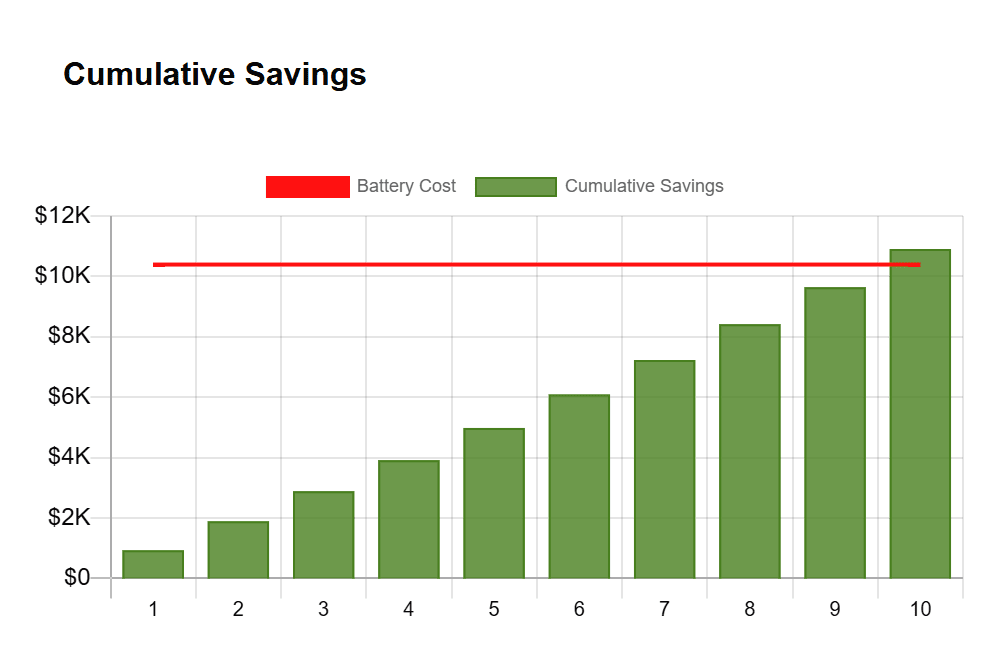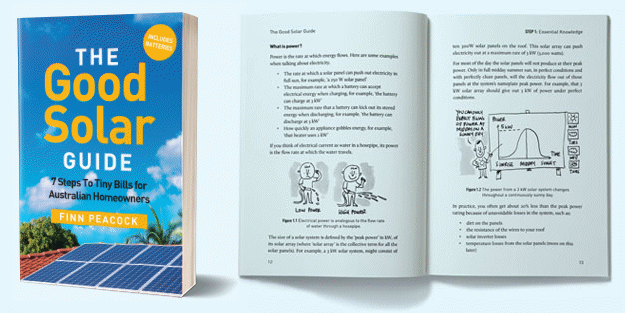
Federal Attorney-General Mark Dreyfus spruiks Labor’s Cheaper Home Batteries Program.
Labor’s election promise of a federal battery incentive is eye-catching enough on its own, but especially lucrative is how it can potentially be combined with state-level schemes. We’ve run the numbers to calculate the savings from double-dipping, and they’re big — but so are the potential issues.
Labor’s proposed $2.3bn Cheaper Home Batteries Program offers an incentive for Australians that offers roughly $372 per kilowatt-hour of useable capacity, minus fees (we have more detail on the policy here).
But how much does this actually shave off the cost of a home battery, and what about when combined with a state-level scheme?
Savings From Federal Labor’s Proposed Battery Incentive
The Cheaper Home Batteries Program would be delivered under the longstanding federal incentive scheme for solar, via Small-scale Technology Certificates (STCs).
SolarQuotes resident fact-checker Ronald Brakels has scrutinised the available information on Labor’s promised scheme. Even when assessing a relatively expensive battery in the 13.5 kWh Tesla Powerwall 2 as a case study, the price does become much more accessible.
Ronald estimates that the proposed federal incentive could shave between $4,000 and $4,500 off the cost of a Tesla Powerwall 2, based on an initial purchase price of $15,500 (although note that this does not factor in potential price changes from fluctuating tariff levels):
“With an STC price of $40, the maximum reduction from Labor’s National Battery Incentive for a Powerwall 2 will be $5,000. If, after administration and compliance costs, the price reduction is $36 per STC — the same as commonly received for rooftop solar — then the price reduction would be $4,500. But compliance costs for batteries could easily be higher and there are also start up costs involved in getting used to a new incentive. If it’s assumed the price reduction per STC will be $32 as a result of this, then the incentive would reduce a Powerwall 2 price by $4,000.”
Combining Federal and State Battery Incentives
Labor has pledged that its scheme will be stackable on top of existing battery state subsidies. One of the most notable is the NSW Battery Incentive, which is based off the fluctuating price of PDRS certificates (PRCs), which Ronald has factored into his NSW-based case study:
“RC prices vary. At the moment households may receive $1.70 each. At that price the NSW battery incentive will lower the cost of a Powerwall 2 by $1,830. The number of PRCs received can slightly vary between locations, so the figure may be a little different in Paramatta than the Eastern suburbs 2000 postcode I used. With a $1.70 PRC price NSW incentive of $1,830 and if the national incentive is $4,000, these combined will bring the total reduction in price to $5,108.
If the installed cost of a Powerwall 2 would be $15,500 without incentives, then after the NSW and proposed national incentive are applied, it will lower the cost to the homeowner to $10,392. That’s 33%, or one-third off the cost of the battery. These figures however don’t include the price increase that usually results when a subsidy is introduced, or the extra discounts you could secure from joining a VPP.”
Try our new federal battery rebate calculator to see how much you could save off your preferred battery.
What Does Labor’s Incentive Do To Battery Payback Time?

The potential payback time of a Tesla Powerwall 2 should Labor’s incentive scheme be introduced.
By inserting a sample of power use data in SolarQuotes Battery Calculator on a Diamond Energy time-of-use plan, and manually applying a 33% discount to the Powerwall 2 to cut the cost to $10,392 to reflect both NSW and federal incentives, the payback time goes down from 13 years to 10 years.
The discount would be much steeper for more mid-range batteries, approaching 50% for a range of reputable brands.
To see what the federal incentive scheme alone would do to the price of your preferred battery wherever you live in Australia, insert your details into our battery calculator, but just reduce the cost by 25% in the field for the cost of the battery price, for a rough conservative estimate of how much it would reduce payback time.
Be mindful that the Labor program is just an election promise and will mean nothing if they don’t secure victory.
What Problems Could Double-Dipping Create?
Going for a bottom-of-the-line cheap battery could eliminate most of the cost, which is likely to attract dodgy operators seeking to make a quick buck who offer up “free” batteries without the technical proficiency to do installs properly. Regulators will need to be conscious of the potential dangers here while finalising the rules should Labor win the election and make this incentive a reality.
The proposal does specify that batteries must be Clean Energy Council (CEC) approved, which offers a theoretical safeguard in terms of battery performance, but not against unscrupulous operators.
There’s already suspect promotions proliferating even in states without their own subsidy, such as South Australia, where one company is spruiking an information day falsely suggesting that the incentive is a “SA Government” offer and giving the wrong idea that the grant is actually available, rather than just an election promise. Since this article went live, 1KOMMA5° has since taken the ad down.

Not advisable to attend this “information day”, given how much misinformation is in the advertisement alone.
Will Double-Dipping Battery Schemes Actually Be Allowed?
Although federal Labor has pledged its scheme can be stacked with state schemes, the rules of NSW’s scheme need to be amended to realise this. It has been flagged under the PDRS Amendment No.3 Section 5.4 “that an activity is not a recognised peak activity” (e) “if it is eligible to create tradeable certificates under the Renewable Energy (Electricity) Act 2000.”
So this means the schemes aren’t stackable as it stands now.
On Wednesday, SolarQuotes in-house installer Anthony Bennett spoke with officials within the NSW Government, and reports that they’re acutely aware that quality must be policed. Regulators are working on changes to address this issue.
Anthony notes that there are a host of other issues with the NSW scheme that fellow solar industry figures would like to see improved:
“Most importantly, major gains would be made if NSW simply had a price cap instead of a capacity limit, whether the federal proposal comes to pass or not. Right now, the NSW rules mean a battery bigger than 28kWh will get zero incentive. This becomes an artificial ceiling, especially when the feds subsidise 50kWh and don’t cap it until you hit 100kWh … 100kWh stops the bigger commercial setups being subsidised, but a decent small business will still get a good bang for buck.
As for the federal program, it’s been welcomed. However despite already being very highly regulated, many installers are calling for compulsory inspections before funds are paid. We don’t want a pile of cheap batteries covered in subsidy-seeking blowflies.”
What State Battery Schemes Exist?
A host of State and Territory governments offer support for battery purchases:
| State / Territory | Program Name | Type | Value |
|---|---|---|---|
| Northern Territory | Home and Business Battery Scheme | Grant | Up to $12,000 |
| New South Wales | NSW Solar Battery “Rebate” | Rebate | Up to ~$4,470 (Varies by PRCs) |
| Victoria | Victorian Solar Battery Loan Scheme | Zero-interest Loan | Up to $8,800 |
| ACT | Sustainable Household Scheme | Zero-interest Loan | Up to $15,000 |
| Western Australia | WA Residential Battery Scheme | Rebate + Zero-interest Loan | Rebate: Up to $7,500 Loan: Up to $10,000 |
For more detail on battery rebates, take a look at our comprehensive guide on federal, state and territory offers, or go deeper with our dedicated pages on the NSW scheme, WA incentive and Labor’s proposed federal program.
And if you want to calculate how much Labor’s proposed incentive could save you, try out our new federal battery rebate calculator.

 RSS - Posts
RSS - Posts



All pie in the sky until the election is won.
Then even then, if Labor wins, who is naïve enough to think any Labor legislation can get through the senate unchanged. Or at all. Remember the housing fund which one would have thought was a no brainer for support from the independents and the greens who had long made noise about housing affordability, yet the Greens blocked it anyway.
Definitely a case of dont count your chickens until the eggs have well and truly hatched.
Very true that this policy is only an election promise, which we’ve noted a few times in the piece. It will not need to get through the senate or require legislation though, just a regulatory change to the Small-scale Renewable Energy Scheme.
Last i checked spending 2 billion odd dollars required inclusion in a supply bill. The government can not spend money not allocated by the parliament.
Existing scheme, funds included in recent federal budget.
It doesn’t require any legislation, just a sworn in minister. It was designed specifically to not require it, which is why it can be deployed from 1 July.
I expect there will be a lot of Croweaters currently getting the Premium Feed in Tariff who will be running their numbers on the value of a battery now rather than in 2028.
I think Labor’s scheme will eventually lead to installed storage prices falling much further.
It would be more beneficial to people already with solar panels to have the feed in tariffs restored to where they originally started
Hi Alex,
Large scale storage like Snowy 2.0, grid scale or community batteries might drive up the price of daytime electricity but we can’t really incentivise export into a flooded market. Distributed batteries give people the tools and the personal interest to make behaviour changes which is the best outcome.
While I think there must be a mandated minimum, to make sure people still remain engaged with the grid and able to export, ramping up payments is something we’ve written about here.
So how would “This is likely to attract dodgy operators seeking to make a quick buck, who offer up “free” substandard batteries” work ?
Don’t all batteries have to, at least, be Compliant to CE / IEC62619 / Ul1973 / UN38.3 and Clean Energy Council (CEC) approved ?
Maybe I’m naive thinking SAPower ( in my case) would approve non-compliant batteries – I’m sure they wouldn’t.
I’m waiting ( hoping ) the RIiXU will one day make the grade
The proposal does suggest CEC approval is needed, which is worth noting and we’ve updated the article. It’s not going to stop the kind of unscrupulous operators that get attracted to big incentive schemes like this however.
I’ve done the sums several times since I had my 6.6kWh system installed three years ago and this simply wouldn’t work for me in an economic sense. In winter I get barely five hours’ sunshine on a good day, which doesn’t even run my reverse cycle a/c during daylight hours (I’m retired and at home all day), let alone producing enough energy to charge a battery for overnight and early morning. I also considered high-efficiency electric storage heaters but rejected them for the same reason.
I’m fortunate that I can cut firewood for nothing and my slow combustion stove fills in the gap between late afternoon and 10am.
Low-tech, hard work and dirty but a log fire is the the most enjoyable form of heat anyway. Silent, draught-free and cosy 🙂
Kerry,
Cutting, carting, and splitting that firewood keeps you fit – and the splitting helps keep an old back supple, I find. (Mind you, I’ve moved down out of the Dandenongs, reducing annual consumption from 8+ tonnes to about 1 now, what with double glazing, insulation, and 400 feet less altitude.)
If you have any mostly unshaded spare roof, then “More Panels” is the go.
In deep overcast, my 27 kW of panels yield only 2 or 3 kW, but that’s ample for a 3.6 kW aircon or a bit of EV charging. Even if the extra panels are south facing, they’re just as good as north or west in the diffused insolation from an overcast sky. In clear winter skies, my 40° tilted north-facing panels yield 3x better than south-facing 14° tilted, here at 38° south. Off-grid, the battery has never been below 79% SoC, so no generator starts.
A separate off-grid system, just for an aircon, is perhaps easiest?
But I too will be lighting the wood heater when winter hits. The picture beats anything on TV.
Thanks Erik
I agree with nearly everything you say. Except about more panels. These mean more $$, especially upgrading from 6.6 to somewhere around 27 kWh. Even if I had the roof space, I’d be paying them off for years before I broke even!
Totally agree about the quality of the programming on the stove 🙂
The benefits of batteries are manyfold – including providing backup power (with the appropriate inverter).
When I got my hybrid system, I have a 5kW inverter (the limit for a single phase grid connection on the SWIS grid in WA; the only grid that so limits), 8.36kW of panels, and, a BYD 19.3kWh BESS.
I am on the SWIS Time Of Use fee structure; 8c/kWh 0900-1500, 50c/kWh 1500-2100, and, I think, 26c/kWh 2100-0900.
I have the system configured to charge the BESS, to 100%, between 1200 and 1500. I also have the system configured to reserve 25% of the charge, for backup.
With this configuration,I generally have enough power from the BESS, to get me through the peak pricing period each day, thence reducing the grid electricity costs. That goes through winter, when I might get as little as 4-6kWh of electricity generated by by the system (yet another reason why the limit on household single phase photovoltaic inverter, should be increased to 15kW, the same as for 3 phase grid connections.
Regarding the text in my above post; “I have the system configured to charge the BESS, to 100%, between 1200 and 1500.”, that involves drawing power from the grid, between those times, to make up the shortfall in the battery charging. That costs 8c/kWh, and, has two separate but related benefits. The first, is that it generally ensures that I have enough charge in the BESS, to get me through the peak period, where the pricing is 50c/kWh, and, it provides energy arbitrage – reducing demand in the peak period. So, it is financially beneficial to this household, and, it helps stabilise the fragile electricity grid.
Tasmania’s Energy Saver Loan Scheme offers interest-free loans for a range of energy efficient products, including battery storage. Loans are available up to $10,000.
Can someone please explain why our imported batteries are so expensive given that I can pick up a 20kWh LiFePO4 battery with inbuilt inverter and guaranteed for 8000 hours from China. I mean how much should the wiring cost? This is not some dodgy fly by night company, as my son who is fluent in Chinese checked it out.
It seems to me that there is some serious price gouging going on!
Yes, I have seen on some Chinese websites modular batteries at $100US kWh. Not installed obviously but I do think we are paying the ‘Australia Tax’
I hope Labor’s policy encourages competition among brands and installers and brings the prices we are currently paying down.
Rudi, 8000/24 = 333 days. Replacing the significant investment around once a year would quickly grow old. It’s the icecream melting in the fridge, here off-grid, which would annoy more than a little, not to mention blackout of lighting and internet. Perhaps you could buy a 6-pack of the unreliable product, and stack them in the garage, if they’re cheap enough, but installation costs would pile up painfully too.
I have 48 Chinese (EVE) LiFePO₄ cells, and expect them to last a couple of decades. Add a reputable battery inverter for uptime you can rely on, I’d suggest. The Chinese (Jikong) BMSs are good too, with a nifty phone app for monitoring and management. It pays to know what you’re buying, *especially* off the web.
And if you’re on-grid, your stuff will have to be even more officially approved.
(No bad thing, as smoke and fire are more excitement than we need.)
If confident, a 2nd off-grid battery system might be an option?
I think he meant cycles, not hours.
That’s plausible, Alex, with the latest LiFePO₄ chemistries.
Now we just need to know the price and supplier reliability, i.e. have a bunch of satisfied buyers gone before us?
Mind you, if the cells are manufacturer-supplied EVE or CATL, then it’s just about the BMS brand, and inverter, if included.
Rudi, there’s freight, and 10% GST payable on arrival, no local presence, and no local warranty. Add that plus reseller costs, taxes, & profit, then local purchase must be substantially dearer, I figure.
Compare Coles & Woolies fruit & vegetable prices with what the farmer gets. Retailing costs a lot, justified or not.
Yes I did mean cycles, and I take your point about retail mark ups, but a factor of 6X is a bit rich. I’m given to understand that the blade style LiFePO4 are inherently much safer from a flammability perspective. We need some figures on the ball park cost figures if installing a battery with smart inverter within a couple of metres (max) from the switchboard.
Will you be able to get multiple batteries? Can I buy 1 now and another 6 months later and still get the rebate on the second one? Assuming Labor wins
From other than articles yes additional capacity can be added to exisiting systems provided it is connected after 1/7/2025 see Reneweconomy
SA has battery subsidies via the REPS program, but is only applicable if you signup to a participating VPP
But at the end of the day, without certification and CEC approval it doesn’t matter how cheap or from which suppier, you won’t be able to connect (legally)
If i kept $15k in a home loan offset account for 10 years, it would reduce my interest payments by around $10k.
So to make financial sense, a $15k battery needs to pay itself off well before 10 years, and go on to make $10k profit.
Even with the rebate, they’re too expensive.
Hi Jarrah,
You could probably make an inspired crypto investment or poor choice of car with your money but presently there are about 20% of solar installations that already include solar. People are choosing them because the price of a freezer full of food, and the inconvenience of replacing it, means it can be well worth having a battery.
That the battery helps with your bill every day is seen as a bonus you won’t get from a diesel generator.
There seems to be an assumption that everyone needs protection from “outages” and ruined freezer contents.
My local supply used to blackout for short periods which was inconvenient but never ruined food. The only time I was seriously inconvenienced was in Canberra during the 2003 bushfires and the first documented fire tornado started down the end of the street, lopping down a massive gum tree at the street frontage and depositing it on my roof. This cut off power from the grid for a week or two and destroyed the contents of fridges and freezers (covered by insurance) as well as much other damage. Of course, if I’d had solar in those days the panels would have been destroyed and probably not replaced for weeks, meaning a battery – if it miraculously survived – would have quickly become as useful as a boat anchor.
In my circumstances (not so unusual although I now live in a tiny village) I have yet to read an argument for home batteries which makes economic sense at any price.
I understood WA rebate was up to 5000k
WAs new Residential Battery Scheme is launching by July 1, 2025, with rebates up to $5,000.00 for Synergy customers or $7,500.00 for Horizon Power customers.
I paid $10,500 for Powerwall 2 6 months ago with NO rebates from government, so you’re telling me it’s only $170 cheaper with 2 government schemes stacked?? Can’t be right…
So let me get this straight … if right now, a typical system (10-20 kWh) is about $11,000 – $22,000 installed, (before rebates), then you take 30% off ..say $12,000 = $ 8,000.
Then you minus off WAs new Residential Battery Scheme (launching by July 1, 2025,) with rebates up to $5,000.00 for Synergy customers or $7,500.00 for Horizon Power customers. = $5000 (for Synergy)
Total out of pocket up front cost is potentially $3000 in WA… correct?
Hi Trevor,
As far as we know that’s correct. The federal scheme is designed to be stacked with state incentives in NSW, WA, NT or wherever else they apply.
Does anyone have any indication as to whether or not you will be able to claim STC’s in the scenario of swapping an old inverter out for a hybrid and DC coupled battery (CEC listed of course) but with panels that are no longer on the approved list?
Or will homeowners with existing systems not on the current CEC listing have to AC couple batteries?
Again, theoretical at this stage as anything could happen but it’s a question I have been posed as an installer and business owner.
Hi Toby,
Having sat in on the briefing with Minister Bowen & Co before the election, they were keen to make sure the program didn’t instigate more waste but were admitting all the details were not settled.
DEECA in Victoria have been keen to make sure old solar PV was grandfathered when new backstop compatible systems were installed, again to make sure good systems weren’t binned.
I suspect if you are making a repair to some existing array wiring, by adding a couple of new connectors, then plugging it into a new inverter, there should be no issue with using existing solar.
Tesla have certainly said they don’t see legacy solar as being a reason to invalidate the warranty on a PW3.